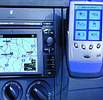

Telematic systems combining GPS and wireless networking are poised for mass penetration of motor vehicles. This article from Epcos describes how the company's mechanically rugged and highly selective, surface acoustic wave filters are ideal candidates for use in automotive telematics.
Automotive telematics integrates conventional isolated solutions from telecommunications and information technology on a common wireless platform. It delivers information, communication, safety, consumer and entertainment services straight to motorists on the road. Modern telematic systems can be classified as follows:
Call-centre-based systems: These set up a hands-free mobile radio voice link to a telephone hotline at the push of a button. A GPS signal is simultaneously sent from the vehicle to the call centre via the mobile radio link so that the call centre agent can locate the car and guide the driver to the desired destination with spoken instructions. A call-centre-based telematic system usually comprises a GPS module, which contains one SAW component, and a single or dual-band mobile radio module, which requires three to six SAW components, depending on design. Call-centre-based systems predominate in the United States, where OnStar is the best-known and leading provider.
Self-contained navigation systems: These store route data on board electronically, eg, on CD-ROM, DVD, or, more recently, on HDD. They are mainly found on the highways of Europe and Japan. Using GPS and in-car sensor data to locate the vehicle, they calculate the fastest or shortest route to the specified destination. A self-contained navigation system usually contains a GPS module. A telephone module is currently only used for high-end products with additional wireless functionality. Telephone modules will pervade navigation systems as these additional services spread.

The classic applications of SAW filters in automotive electronics are radio-based keyless entry and, more recently, tyre pressure monitoring, where SAW filters in roll-seam-welded, hermetically sealed ceramic packages for surface mounting are insensitive to heat, cold, dirt, moisture, vibrations, and acceleration forces. Further telematic applications for SAW filters include:
* Front-end and transmit filters for transmit and receive modules in the short-range device frequency band (868-870 MHz), eg, floating car data.
* Front-end and transmit filters for modules designed to trace stolen vehicles;
* RF and IF filters for GPS modules;
* RF and IF filters for GSM/GPRS/UMTS mobile radio modules;
* Front-end filters for terrestrial and satellite radio systems.
Market research institutes have already identified an emerging phase of significant growth in automotive telematics. They forecast a world market volume of almost 25 bn by the year 2007, equivalent to annual growth of up to 20 million telematic systems by 2007. Whereas only 5% of all new vehicles are currently equipped with telematic systems, the Telematics Research Group optimistically expects penetration to reach 33% by the year 2007.
As promising as these figures may sound, R&D engineers working on components for automotive telematic systems still face some fundamental problems. Once terminal modules have been installed in an automotive telematic system, they must meet not only consumer quality standards but also automotive standards. This means that a filter originally designed to work perfectly in the range from -20 to +70°C in a mobile phone must now operate without a glitch at -40 to +85°C or even up to +125°C in an automotive module.
These are tough demands in two respects. Firstly, the temperature drift inherent in every SAW filter increases, so that certain required signals no longer pass through the passband and are inadvertently suppressed. This effect can be offset by extending the frequency range of the passband, but here limits are set by potential noise. And as the temperature range of IF filters for mobile phones has already come up against its limits in the consumer field, any further extension would soon cause yield problems in production. Secondly, automotive component qualification tests now being applied, such as US specification AEC-Q200 for passive electronic components, demand that tough tests be passed.
These are: 1000 hours of high-temperature storage at +125°C, equivalent to 56 years of operation at normal temperatures; 1000 temperature cycles from -40 to +125°C; 1000 hours of storage in humid heat: 85% relative humidity, 85°C and maximum specified voltage; 1000-hour operational life test, 130°C at maximum specified power; and resistance to vibrations, ESD, shearing force, chemicals, etc.
The results of these qualification tests clearly show that SAW components in tried and tested ceramic packages for surface mounting still have substantial advantages over newer package technologies. But this also imposes constraints on development of SAW components for automotive applications.
After decades of cooperation with the automotive industry, especially in keyless entry systems, Epcos is well aware of automotive quality requirements. Certification of its SAW components plants in Munich and Singapore to ISO 9001 and to automotive standard ISO 16949/QS 9000 are documentary proof of Epcos' superior quality standards. An integral part of the latter standard is the PPAP (production part approval process) quality document, which certifies that Epcos, thanks to its advanced design and production processes, can produce a specific component in defined and reproducible quality. Whenever a SAW component scores a design win, the customer receives a component-specific PPAP. This is modular in structure and contains a data sheet, component specifications, error source and influence analyses, production figures, sample components with test records, a process and monitoring plan, and the results of a qualification test to AEC-Q200 for a specimen of the SAW component family under review.
Summary
Rugged design makes SAW filters from Epcos ideal for automotive telematic applications. They offer designers the following advantages:
* High mechanical resistance to vibrations and shock thanks to ceramic packaging;
* Very wide temperature range from -40 to +125°C;
* Low passband frequency drift across the entire temperature range.
| Tel: | +27 11 458 9000 |
| Email: | [email protected] |
| www: | www.electrocomp.co.za |
| Articles: | More information and articles about Electrocomp |

© Technews Publishing (Pty) Ltd | All Rights Reserved